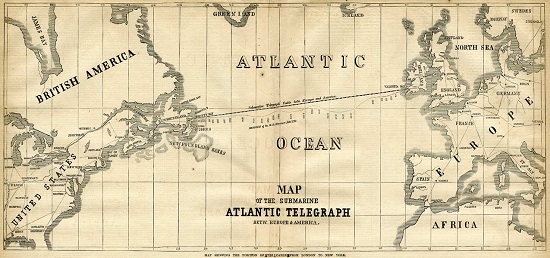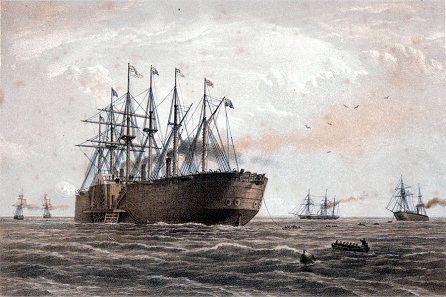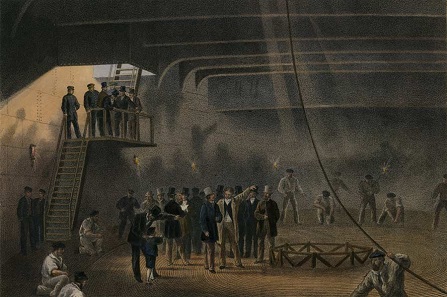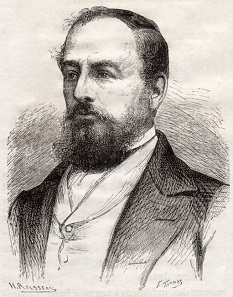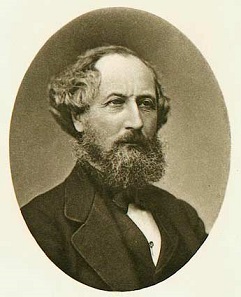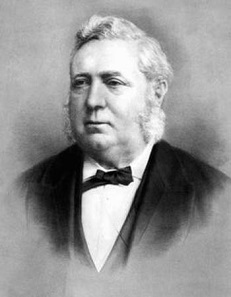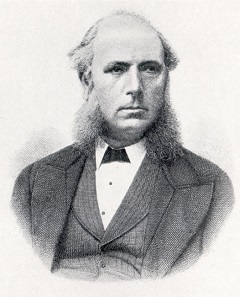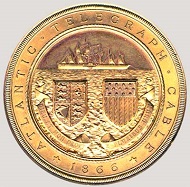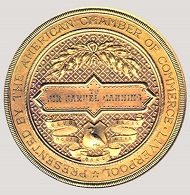by Herman Blanton
July 28, 2016 – The completion of the Transatlantic Cable in 1866 is an important milestone in history, especially the history of communication. The cable made it possible for North America and Europe to be connected telegraphically for comparatively instant communication, news could henceforth be transmitted between continents in a matter of a few minutes instead of 10 days each way for transatlantic ship passage. The year 2016 marks the 150th anniversary of the successful laying of the cable. The subject medal was presented in 1867 to show appreciation for the efforts spent and risks taken to complete the task.
The 1857 & 1858 Cables
The first attempt at a transatlantic cable was in 1857 as a joint enterprise between England and the United States. Twenty five hundred nautical miles of cable was designed, manufactured and loaded upon two ships, as no single ship was able to handle such a great load. However, the expedition laid four hundred miles of cable before it broke and vanished under the sea. The cost of the failed expedition was £225,000.
Map of the 1858 Atlantic Cable Route (Courtesy of Bill Burns). From Frank Leslie’s Illustrated Newspaper, August 21, 1858.
In 1858 the second expedition commenced, the chief engineer was William Everett, who designed a new ‘paying out’ machine for laying the cable. This year two ships each carrying half the cable met in the mid north Atlantic, spliced the cable ends and laid cable in both directions simultaneously. However, the cable did not function very well and it was until August 16th that the first official message was transmitted, a letter of congratulations from Queen Victoria to President Buchanan, within a month however, the cable had failed completely.
The Great Eastern under weigh, July 23: escort and other ships introduced being the Terrible, the Sphinx, the Hawk, and the Caroline. Image drawn by Robert Dudley and included in William Russell’s book The Atlantic Telegraph, published in (1865). Provided here courtesy of Bill Burns, who operates the Web site History of the Atlantic Cable & Submarine Telegraphy (accessed 1 July 2005).
The Great Eastern
Before another attempt to lay a cable could be made, the US Civil War erupted putting the project on hold, it would be 1865 before another expedition was started.
In the meantime the world’s largest ship was completed in 1858 and put into service, the Leviathan, renamed the Great Eastern.
Coiling the cable in the after-tank on board the Great Eastern at Sheerness: visit of H.R.H. The Prince of Wales on May 24. Image drawn by Robert Dudley and included in William Russell’s book The Atlantic Telegraph, published in (1865). Provided here courtesy of Bill Burns, who operates the Web site History of the Atlantic Cable & Submarine Telegraphy (accessed 1 July 2005).
The 1865 Cable
For the 1865 expedition the cable was redesigned, both the copper core and the insulation. When the expedition was within 600 miles of Newfoundland, another fault was detected, during the retrieval of the cable it broke and vanished, again, under the sea.
Reparation did not help, at the end there was not enough cable left to start over, so the expedition returned to England, a failure, yet again.
The 1866 Cable
Learning from the 1865 expedition, changes were made in the cable design, to the cable paying out machine and to the Great Eastern itself. With these changes the crew could retrieve the cable by running the paying-out machine in reverse without snagging the cable in the ship’s propeller.
With the shore end of the cable landed in Ireland, the Great Eastern started out on the inauspicious day of July 13th 1866, a Friday. On July 27th, 1866 the cable was spliced with the shore-end at Heart’s Content Newfoundland, the cable was laid. Cyrus Field sent the following report to New York, ‘Heart’s Content, July 27 – we arrived here at nine o’clock this morning. All well. Thank God, the cable is laid, and is in perfect working order. Cyrus W Field.’ [Field, Henry M. 1893. “The Story of the Atlantic Telegraph.” p. 344.]The expedition now turned to the task of retrieving and splicing the 1865 cable, some 600 miles to the east. For more than three weeks and with much difficulty, the ships fished the ocean floor for the cable. Success finally achieved on the 30th attempt, the cable was spliced on September 2nd. After the splice was made at sea, the Great Eastern laid cable westward to Heart’s Content and landed the second cable on September 7th, 1866.
The successful completion of the cable was met which much celebration and recognition in England and the United States. One of the celebrations was the awarding of a gold medal, in Liverpool, the subject of this article.
The primary source is the minute books of the American Chamber of Commerce, Liverpool. The Chamber was founded in the year 1801, in Liverpool, as an English association to promote trade between England and the USA. The association was dissolved in 1908. A survey of the minutes tells that cotton was the primary trading commodity. As the telegraph cable project overlapped the US Civil War, the minute books are an interesting read from the cotton trade aspect as well as the subject medal.
The Chronology of the Medal
The main company of the expedition arrived back in England in September; this is when the history of the medal commences.
As “The Illustrated London News” reported on March 30, 1867: “The American Chamber of Commerce at Liverpool resolved some months ago that a gold medal should be made and presented by the Chamber to …
Sir Samuel Canning
… Sir Samuel Canning, chief engineer; …
Mr. Cyrus W. Field
… Mr. Cyrus W. Field, of New York, the original projector of the Atlantic Telegraph; …
Captain Sir James Anderson
… Sir James Anderson, the Commander of the Great Eastern steamship; …
Mr. Willoughby Smith
… and Mr. Willoughby Smith, the electrician, in commemoration of the successful laying of the Atlantic Telegraph cable.
It should be observed that the American Chamber of Commerce is the oldest commercial association in Liverpool, having been founded in the year 1801, principally through the instrumentality of the late Mr. William Rathbone. The Chamber consists of the principal firms in Liverpool, English and American, engaged in the American trade, which as many of our readers are aware, is the most important branch of commerce in Liverpool. It has also, on several occasions been instrumental in effecting improvements of the mercantile law of this country. The Merchants and Factors Act, of 1842, which effected, in that branch of the law probably one of the greatest improvements of modern time, was originated and finally carried mainly by efforts of this Chamber. The Bill of Lading Act, of 1855, another public measure, by which the remedy of consignees of cargo for damage to goods on shipboard was greatly facilitated, was likewise obtained by the American Chamber of Liverpool.
The medal, of which we give an Illustration, was designed and manufactured by Mr. Wyon. It is of solid gold, weighing more than three quarters of a pound. On one side is represented the Great Eastern steam-ship, in full sail upon the ocean, encircled by the words ‘Atlantic Telegraph Cable,’ with the heraldic arms and legends of the kingdom of Great Britain and of the United States of America beneath the ship. On the reverse side is engraved in a scroll cut specially for each of the four gold medals the name of the gentleman to whom it is given, below which are the arms and legend of the town of Liverpool.
The medal as it was shown in the article.
The presentation took place, on the 14th ult., at a banquet given by the Chamber to the four gentlemen we have named and to the Hon. C.F. Adams, the Minister of the United States in this country. The entertainment was sumptuously and elegantly prepared in the Law Association Rooms, Cook-street. Mr. William Rathbone, jun. (grandson of the late Mr. William Rathbone, who founded the Chamber) occupied the chair on this occasion; but Mr. Gair, being at the present time the president of the Chamber; also took part in the proceedings. Sir Samuel Canning was, unfortunately, not able to come; but Mr. Cyrus Field, Captain Sir James Anderson, and Mr. Willoughby Smith were seated on the Chairman’s right hand, while the American Minister sat on his left. The Mayor of Liverpool, the United States Consul (Mr. T.H. Dudley) and the Vice-Consul, the Hon. C. Fisher, Attorney-General of New Brunswick; Major-General Sir John Garvock; Captain Prowse, R.N.; the Venerable Archdeacon Jones; Mr. Ralph Brocklebank, chairman of the Mersey Docks and Harbour Board; Mr. Malcom Ross, president of the Manchester Chamber of Commerce; and Mr. Hugh Mason, chairman of the Lancashire Cotton-Spinners’ Association, were among the guests, and had the occasion to speak in their turns. Mr. Rathbone, who performed the honours of the table with much grace, proposed the health of the ‘Projector of the Atlantic Telegraph and his Assistants at Laying the Cable,’ at the same time handing a medal to each of the three gentlemen present, Mr. Cyrus Field, Sir James Anderson, and Mr. Willoughby Smith, who were entitled to receive it. These gentlemen returned thanks, and several other toasts were proposed and acknowledged. A telegram was sent from the dinner-table to President Johnson and received in less than half an hour in Newfoundland.”
The Atlantic Medal
The four gold Atlantic Cable medals were made by the firm J.S. and A.B. Wyon of 287 Regent St. London. This is the address noted in the correspondence; the address imprinted inside the medal case is “2 Lanham Chambers, London, W.” Joseph Shepherd Wyon and Alfred Benjamin Wyon were brothers, members of the famous Wyon family of medallists and engravers.
Obverse of the medal.
Obverse: The shields of Great Britain and of the United States, superimposed upon the ocean, with mottoes below. Above is the Great Eastern steamship. The motto on ribbon beneath the shield of the United Kingdom; “DIEU ET MON DROIT.” The motto on ribbon beneath the United States shield: “E PLURIBUS UNUM.” The central design is appropriately surrounded by an unbroken length of cable. The peripheral legend, “ATLANTIC * TELEGRAPH * CABLE * 1866 *” The medallists’ mark, “J.S. & A.B. WYON SC.” located beneath the UK motto. SC is an abbreviation for the Latin sculpsit “he (they) engraved it.”
The medal’s reverse.
Reverse: The central design on a field of stars has two laurel branches above, the recipients name inscribed in a frame in the center and at the bottom, the symbol with motto for the city of Liverpool. The motto inscribed on ribbon: “DEUS NOBIS HAEC OTIA FECIT.” The central region is surrounded by an unbroken length of cable. The peripheral legend: “PRESENTED BY THE AMERICAN CHAMBER OF COMMERCE * LIVERPOOL*” The medallists’ mark, “J.S. & A.B. WYON SC.” located beneath the frame. The inscription on the illustrated medal is “TO SIR SAMUEL CANNING.”
A first hand examination of the medal shows it to be bronze with a heavy gold plating, gilt, not solid gold. The medal is 76 mm in diameter, which is 3 inches. The edge is plain and the alignment is what is referred to as “medal alignment” in the US, if rotated on 12 to 6 o’clock axis, both the obverse and reverse are upright. The medal weighs 206.8 grams, (7.29 oz avoirdupois, 6.50 oz troy). If the same size medal were of 22k gold it would weigh approximately 432 grams (15.4 oz avoirdupois, 13.9 ounces troy) using relative density of bronze 8600 kg/cubic meter and gold at 19320 kg/cubic meter. There is no apparent correlation of the medal’s weight with the Illustrated London News account, curiously however, the medal with case weighs 12 ounces avoirdupois, which is three quarters of a pound.
In addition to the four gold medals recorded in the documentation there is a silvered medal, without engraved name on reverse, possibly a trial strike, in the collection of the National Maritime Museum in Greenwich England. The medal is cataloged as number MEC1293 and illustrated on the museum’s Web site. An image of the medal is on the Maritime Museum Web site (accessed 3 April 2013).
This is the abridged version of a more exhaustive article by Herman Blanton which appeared first in the July 2006 issue of The Numismatist, the magazine of the American Numismatic Association and was subsequently reproduced on The Atlantic Cable website.
And much additional material is available in the expanded PDF version.




